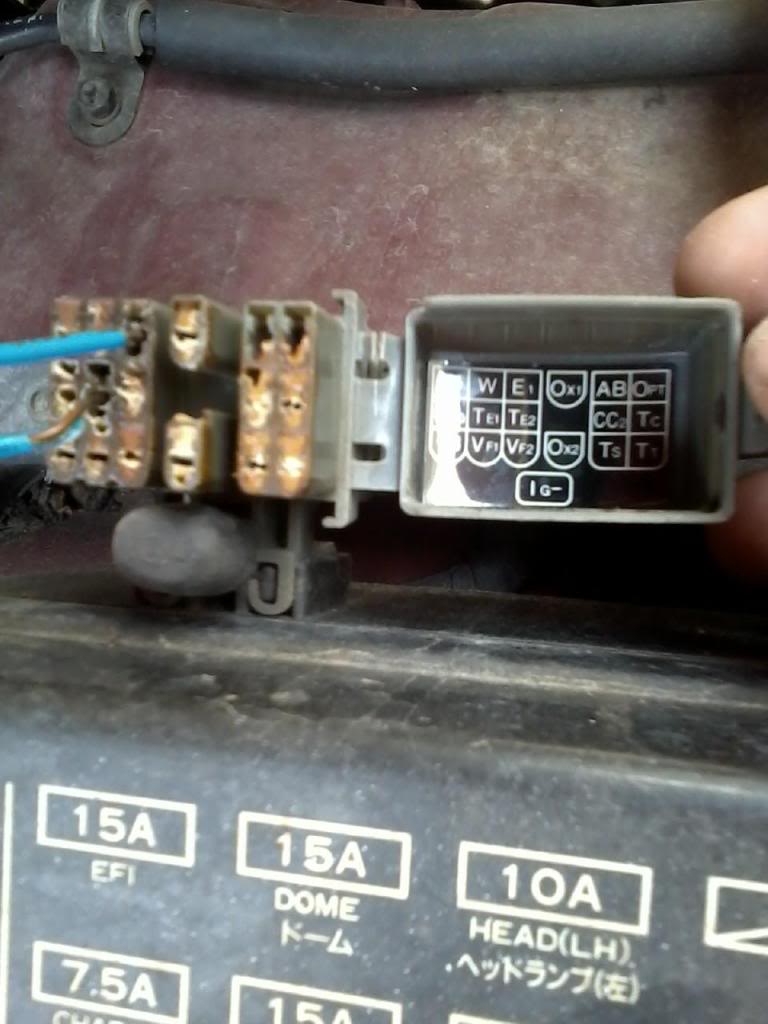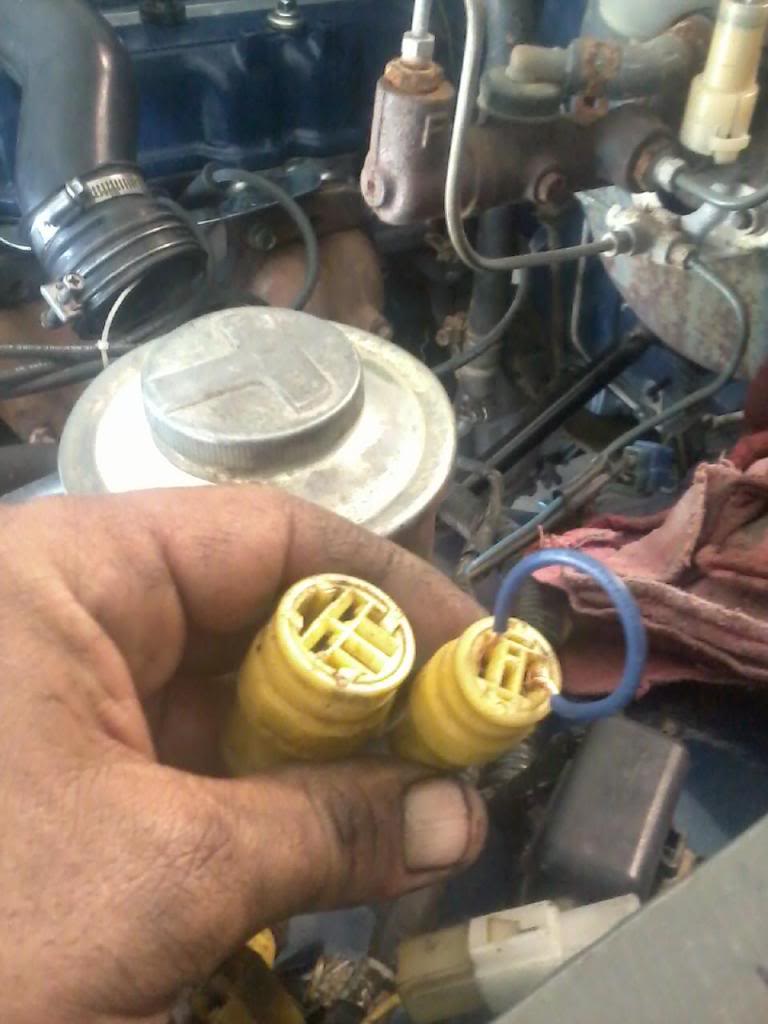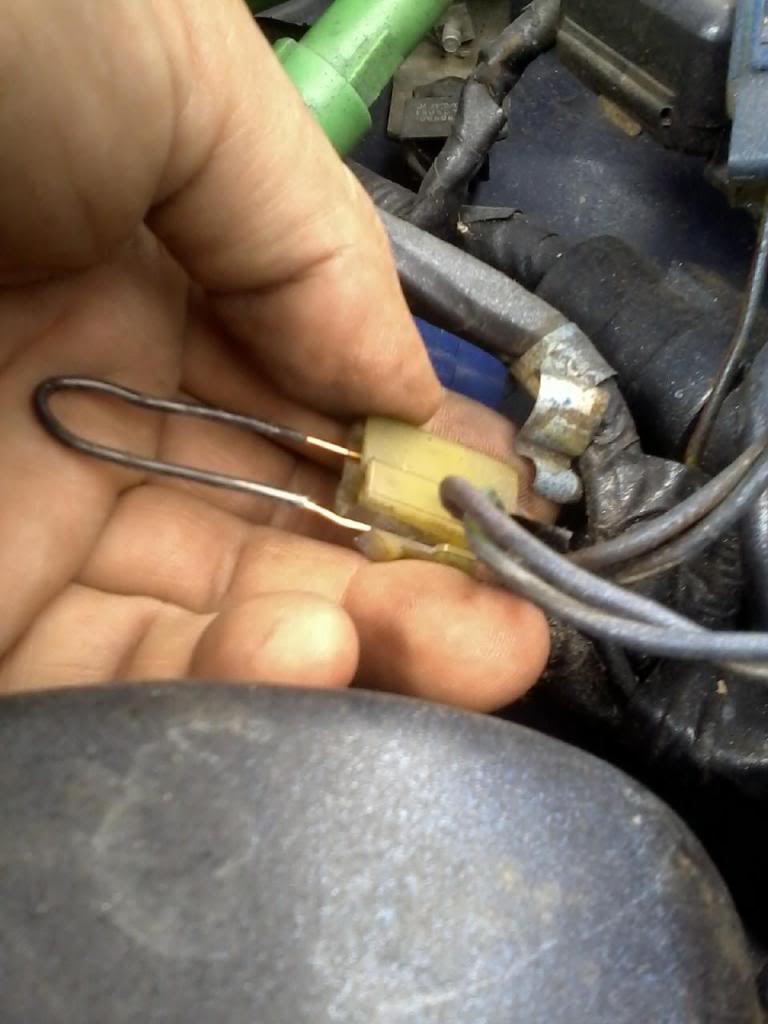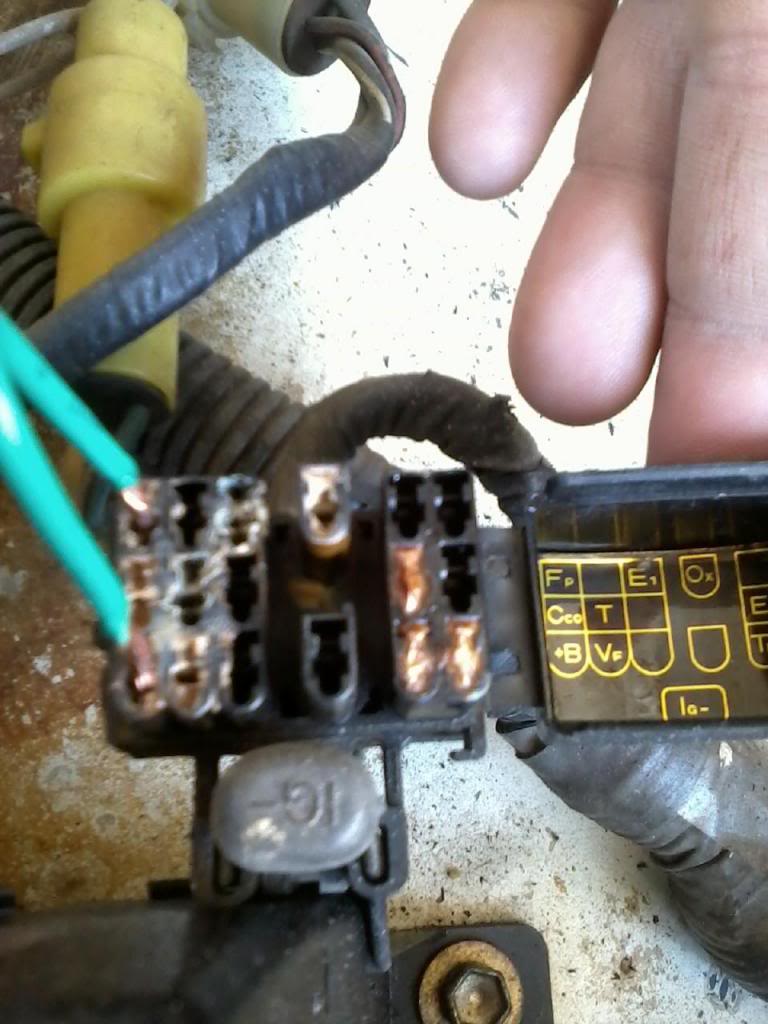1986 4runner 22re Fuel system gurus please help
#1
1986 4runner 22re Fuel system gurus please help
Hi, guys, another fuel question... PUMP NOT WORKING
1986 4runner 22re, been sitting 14 years. Just installed a fully rebuilt 22re.
changed the fuel filter, drained the tank, put in new gas.
I went to prime it, (I just moved the AFM door, and I can hear a relay click, but I dont hear the pump come on. I then read that I dont have to move the AFM door, and I can jump the Fuel Pump on the driver side yellow plug. But when I test the plug, I have 12V on one terminal, and ground on the other, obviously when I tried to jump it. It almost melted the wire.
So my question is , is that a direct lead to the fuel pump, or does it still go the relay? Since one terminal is grounded, would that be a bad Fuel pump?
How would a go about troubleshooting this...?
Thanks in advance.
1986 4runner 22re, been sitting 14 years. Just installed a fully rebuilt 22re.
changed the fuel filter, drained the tank, put in new gas.
I went to prime it, (I just moved the AFM door, and I can hear a relay click, but I dont hear the pump come on. I then read that I dont have to move the AFM door, and I can jump the Fuel Pump on the driver side yellow plug. But when I test the plug, I have 12V on one terminal, and ground on the other, obviously when I tried to jump it. It almost melted the wire.
So my question is , is that a direct lead to the fuel pump, or does it still go the relay? Since one terminal is grounded, would that be a bad Fuel pump?
How would a go about troubleshooting this...?
Thanks in advance.
#2
Registered User
iTrader: (1)
Joined: Apr 2009
Posts: 13,381
Likes: 99
From: I live in New Tripoli Pa out in the woods
No jumping B+ to FP bypasses all the pump safeties .
Bad pump or a short in the circuit.
If it has not run in 14 years no telling what the sock on the fuel pump is like.
Your lucky the 4runner has the access plate to get to the fuel pump .
Bad pump or a short in the circuit.
If it has not run in 14 years no telling what the sock on the fuel pump is like.
Your lucky the 4runner has the access plate to get to the fuel pump .

#3
Ok but mines a 86 , there isnt a diagnostic port, there is only a few open plug ends on driver side inner fender.
So I gained access to the fuel pump, and the fuel pump is definatly grounded out on blue w/black line wire that is supposed to be 12v to pump. So looks like Ill be replacing pump, ...
Now my new question is, Im getting ground signal, on the blue w/black stripe wire, untill the igntion key is turned on, then it turns to power...does that sound right?
So I gained access to the fuel pump, and the fuel pump is definatly grounded out on blue w/black line wire that is supposed to be 12v to pump. So looks like Ill be replacing pump, ...
Now my new question is, Im getting ground signal, on the blue w/black stripe wire, untill the igntion key is turned on, then it turns to power...does that sound right?
#7
Did you use continuity on your meter to test? One side on the ground and other on the + side of the pump unwired?
Ground and continuity are 2 different things. Please explain what you mean.
In any case the pump is just a coil of fine strained wire. You could read continuity between the (+) and (-) post of the pump. And if you unhook the (+) wire from pump and leave the (-) wire still connected you could read ground potential. So please clarify your testing procedures .
Ground and continuity are 2 different things. Please explain what you mean.
In any case the pump is just a coil of fine strained wire. You could read continuity between the (+) and (-) post of the pump. And if you unhook the (+) wire from pump and leave the (-) wire still connected you could read ground potential. So please clarify your testing procedures .
Trending Topics
#8
Then don't use a "Power Probe."
With the fuel pump plug disconnected from the pump, looking back into the harness the W-B wire is connected to ground, the Blue wire is NOT connected with key-off. It sounds like your Blue wire might be shorted to ground somewhere -- you said that you jumpered (the equivalent of) FP and B+ and almost melted the wire. That sounds like the FP wire is shorted to ground. If it isn't a "perfect" (zero resistance) short, then you'll may be able to measure 12v somewhere along with wire with your power probe, with 12v dropped across your higher-resistance short.
A Power Probe is handy, but you'll need a multimeter now. With the pump disconnected, measure the resistance to ground on the Blue wire. If it is anything less than "infinite," it's shorted, and you need to find that. If it's more than, oh, 2 ohms, you have the high-resistance short mentioned above.
It is possible, or course, that your pump is jammed, so that it pulled a lot of current and melted the blue wire somewhere. When it melted, it shorted to ground. But let's find out first.
With the fuel pump plug disconnected from the pump, looking back into the harness the W-B wire is connected to ground, the Blue wire is NOT connected with key-off. It sounds like your Blue wire might be shorted to ground somewhere -- you said that you jumpered (the equivalent of) FP and B+ and almost melted the wire. That sounds like the FP wire is shorted to ground. If it isn't a "perfect" (zero resistance) short, then you'll may be able to measure 12v somewhere along with wire with your power probe, with 12v dropped across your higher-resistance short.
A Power Probe is handy, but you'll need a multimeter now. With the pump disconnected, measure the resistance to ground on the Blue wire. If it is anything less than "infinite," it's shorted, and you need to find that. If it's more than, oh, 2 ohms, you have the high-resistance short mentioned above.
It is possible, or course, that your pump is jammed, so that it pulled a lot of current and melted the blue wire somewhere. When it melted, it shorted to ground. But let's find out first.
Last edited by scope103; 10-12-2015 at 12:23 PM.
The following users liked this post:
Dernation (04-17-2021)
#9
On an 85/86 the fuel pump by pass is a "T" shaped plug (3rd picture) and not like the 87-95. The brown jumper wire should be making contact with both connectors in the plug. I just posted it for myself for a future reference.
Codes... http://4crawler.com/4x4/CheapTricks/...es/index.shtml
How to get Check Engine Codes. I just put this up for others. Applies to 87 and up. 86 and older is the bottom picture. TE/E1

The Diagnostic port for the 85-86 is on the Drivers side inner fender and is nothing the same as the 87 and up. Here is T1 and E1 jumped. The codes and engine flashes are the same as the rest of the trucks on the dash.

Codes...http://4crawler.com/4x4/CheapTricks/...es/index.shtml
http://www.youtube.com/watch?v=9qEQM...ature=youtu.be
Here is how you do a Fuel Pump Bypass on the 85/86.
Jumper wire the Yellow Plug on Drivers side. ( Jumper wire should be in both contacts for testing, I just didnt have it in for picture purposes and mostly a referece for me at a later time.)

Fp +B Fuel Pump Test for 87 and newer. Use a paper clip for better results.

Codes... http://4crawler.com/4x4/CheapTricks/...es/index.shtml
How to get Check Engine Codes. I just put this up for others. Applies to 87 and up. 86 and older is the bottom picture. TE/E1

The Diagnostic port for the 85-86 is on the Drivers side inner fender and is nothing the same as the 87 and up. Here is T1 and E1 jumped. The codes and engine flashes are the same as the rest of the trucks on the dash.

Codes...http://4crawler.com/4x4/CheapTricks/...es/index.shtml
http://www.youtube.com/watch?v=9qEQM...ature=youtu.be
Here is how you do a Fuel Pump Bypass on the 85/86.
Jumper wire the Yellow Plug on Drivers side. ( Jumper wire should be in both contacts for testing, I just didnt have it in for picture purposes and mostly a referece for me at a later time.)

Fp +B Fuel Pump Test for 87 and newer. Use a paper clip for better results.

Last edited by Terrys87; 10-12-2015 at 01:21 PM.
#10
Hey guys thanks. So when I used the Multimeter, at the pump, neg lead to white wire and red lead to blue wire, Im getting about 3.5 Ohm. So pump is toast?
With the key on or off, on the wire harness side Im getting 59.4 ohm on the white and blue wire. ?? Does that make sense? Those wires would back track to relay correct?
With the key on or off, on the wire harness side Im getting 59.4 ohm on the white and blue wire. ?? Does that make sense? Those wires would back track to relay correct?
#11
I am no help on the actual meter readings.
The way your fuel system works is when you crank the motor, the flapper in the Air Flow Meter activates the Circuit Opening Relay (located behind the passenger front speaker in dash) that activates the fuel pump.
The way your fuel system works is when you crank the motor, the flapper in the Air Flow Meter activates the Circuit Opening Relay (located behind the passenger front speaker in dash) that activates the fuel pump.
#13
Hey guys thanks. So when I used the Multimeter, at the pump, neg lead to white wire and red lead to blue wire, Im getting about 3.5 Ohm. So pump is toast?
With the key on or off, on the wire harness side Im getting 59.4 ohm on the white and blue wire. ?? Does that make sense? Those wires would back track to relay correct?
With the key on or off, on the wire harness side Im getting 59.4 ohm on the white and blue wire. ?? Does that make sense? Those wires would back track to relay correct?
1. Don't ever use an ohmmeter on a powered circuit. Modern meters have modest over-voltage protection (so the 12v on your meter may not have hurt it), but an older moving-needle meter would be wrecked. Plus, a resistance reading on a powered circuit doesn't make any sense.
2. Inexpensive (less than $100) meters don't measure resistance well below 5 ohms; the meter leads alone can have about 1 ohm. The fuel pump SHOULD have very low resistance, so 3.5 ohms is close enough. But you can't tell if the pump is stalled with just resistance. That's where you use your Power Probe (if it's what I think it is). Put 12v on the blue lead and ground on the other; if the pump is stalled or shorted the Power Probe has an integral "circuit breaker" to protect it.
3. With key off or key on, as long as you're not at start, the COR should be open. With the fuel pump disconnected, you should get infinite resistance to ground at the FP terminal. (And don't try to measure resistance with key to start; you should have 12v on FP then.)
Take it one part at a time. Use your Power Probe on pump alone to see if it will even run. Use your multimeter to see if you can get 12v on the B+ port with key-on. Put your finger on the VAF flap to close the COR, to see if you get 12v on FP. Look for 12v at the pump end of the harness under the same conditions.
By the way, the COR has a dual coil; one is driven by the STA signal from the key, the other from the VAF door to keep it closed once the engine starts. If you only have the VAF side, you'll have long cranking just to get the fuel pump to start.
Last edited by scope103; 10-12-2015 at 02:59 PM.
#14
Thanks Scope.
With the power probe, gound to ground, and probe to blue wire, when I send 12v to the fuel pump, nothing happens, the pump does not turn on...and after a few seconds winds up blowing the small fuse in the power probe. So pump is no good.
I will follow your instructions and report what I find later...
With the power probe, gound to ground, and probe to blue wire, when I send 12v to the fuel pump, nothing happens, the pump does not turn on...and after a few seconds winds up blowing the small fuse in the power probe. So pump is no good.
I will follow your instructions and report what I find later...
#15
But to confirm, at the fuel pump, on the wire harness side, with the fuel pump disconnected, the blue wire should have NO resistance correct? And not be reading 54 ohms, which Im reading now...?
#16
Just so I know, do you have an actual brand-name Power Probe? http://www.powerprobe.com/index.php Which one?
According to the website, none of PP I through PP IV have true fuses (I think they have PTC "resettable fuses," https://en.wikipedia.org/wiki/Resettable_fuse which will open up and then "reset" on their own in a few seconds as they cool down. That may be what you meant when you said "blowing the small fuse.")
According to the website, none of PP I through PP IV have true fuses (I think they have PTC "resettable fuses," https://en.wikipedia.org/wiki/Resettable_fuse which will open up and then "reset" on their own in a few seconds as they cool down. That may be what you meant when you said "blowing the small fuse.")
#17
It should be infinite resistance, as it has a direct path to the (open) COR and to the FP connector. Check your Fp connector to make sure it's not sitting in a puddle of sea water or something. Pull your COR (under the glove compartment) and see if that brings it up to infinite.
#18
Just so I know, do you have an actual brand-name Power Probe? http://www.powerprobe.com/index.php Which one?
According to the website, none of PP I through PP IV have true fuses (I think they have PTC "resettable fuses," https://en.wikipedia.org/wiki/Resettable_fuse which will open up and then "reset" on their own in a few seconds as they cool down. That may be what you meant when you said "blowing the small fuse.")
According to the website, none of PP I through PP IV have true fuses (I think they have PTC "resettable fuses," https://en.wikipedia.org/wiki/Resettable_fuse which will open up and then "reset" on their own in a few seconds as they cool down. That may be what you meant when you said "blowing the small fuse.")
Yes, I have the Power Probe 3.
And I have a decent mulit meter, its about 5 years old, digital, has fuse.
And I guess the heat from the sun was getting to me, I dont know why I tested a hot circut in Resistance mode.
Last edited by some drunk guy; 10-12-2015 at 03:53 PM.
Thread
Thread Starter
Forum
Replies
Last Post
WTB[SouthCent]: WTB '88 4runner drivers side front door glass
bennyt4130
Items Wanted
3
10-29-2015 04:07 PM
94yotaky
86-95 Trucks & 4Runners
3
07-23-2015 07:50 AM










